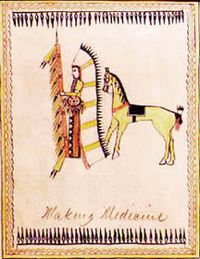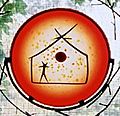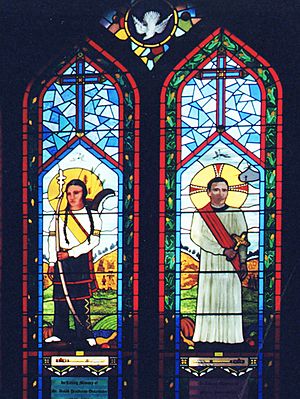David Pendleton Oakerhater facts for kids
Quick facts for kids David Pendleton Oakerhater |
|
|---|---|
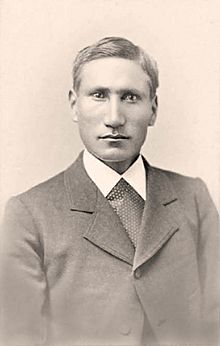
Oakerhater in 1881
|
|
| Deacon and missionary | |
| Born | ca. 1847 Indian Territory |
| Died | 31 August 1931 Watonga, Oklahoma |
| Venerated in | Anglican Communion |
| Major shrine | Grace Episcopal Church, Syracuse, New York |
| Feast | 1 September |
David Pendleton Oakerhater (born around 1847, died August 31, 1931) was a brave Cheyenne warrior and spiritual leader. He was also known as O-kuh-ha-tuh and Making Medicine. Later in his life, he became a talented artist and an Episcopal deacon. In 1985, Oakerhater became the first Native American Anglican to be recognized as a saint by the Episcopal Church.
He was captured during the Indian Wars in 1875. He was sent to Fort Marion in Florida as a prisoner. There, Oakerhater became one of the first important Native American artists. After his release, he went to college in New York. He was then ordained as a deacon in the Episcopal Church. He returned to the West and worked as a missionary in Oklahoma. He helped many Native American people there.
Since 1985, he has been honored in the Episcopal Church's book of Lesser Feasts and Fasts. Grace Episcopal Church in Syracuse, New York is a special place that honors Saint O-kuh-ha-tah. In 2005, a big event was held there to celebrate him, and his family members attended.
Contents
Early Life of a Cheyenne Warrior
Oakerhater was born in the 1840s in a place called Indian Territory. This area is now the state of Oklahoma. His parents were Sleeping Wolf (his father) and Wah Nach (his mother). He was the second of three boys. His childhood name was Noksowist, which means "Bear Going Straight." He grew up following the traditional ways of the Cheyenne people.
Many believe Oakerhater was the youngest person to complete the Sun Dance ritual. His Cheyenne name, Okuh hatuh, means "sun dancer." When he was only 14, he joined his first war party. This was a military raid against the Otoe and Missouri tribes. He also became part of his tribe's "Bowstring Society," which was one of their military groups.
He later fought against United States forces. One of his first battles against white settlers was the Second Battle of Adobe Walls. About 300 Native American warriors attacked a trading village. They were angry because settlers were hunting buffalo, grazing cattle, and stealing horses. This battle, led by Comanche leader Isa-tai and Chief Quanah Parker, led to the Red River War in 1874–75.
Oakerhater married Nomee, also called "Thunder Woman," in 1872. She passed away in 1880. They had four children, but sadly, all of them died young. Oakerhater also married another woman named Nanessan ("Taking Off Dress"). They had at least one child, but they later divorced.
Life as a Fort Marion Prisoner
During the Red River War of 1874 and 1875, the U.S. government tried to stop Native American warriors on the Southern Plains. After many small fights, the warriors, including Oakerhater, surrendered in 1875. They surrendered at Fort Sill in what is now Lawton, Oklahoma. A group of 74 warriors were chosen to be imprisoned in Florida. Oakerhater was among them. They were sent without a trial.
First Lieutenant Richard Henry Pratt was in charge of taking the prisoners to an old Spanish fort. This fort was called the Castillo de San Marcos, but it was known as Fort Marion then. It was near St. Augustine, Florida. The prisoners were chained together for the long journey. They traveled by foot, wagon, train (many had never seen a train!), and steamboat. At first, many thought they would be killed.
Captain Pratt believed that Native Americans should learn the ways of European-American society. He thought they needed to learn English, get jobs, become Christians, and go to school. This idea of changing cultures was called "assimilation." Today, some people call it "cultural genocide." But at the time, many thought it was a good idea.
Conditions at Fort Marion were very bad at first. Prisoners slept on the floor. Several died in the first few weeks. But Pratt quickly made things better. He got army uniforms for them and removed their chains. He also let them work to build a new living area. As trust grew, Pratt even allowed them to carry non-working rifles and do guard duty. They could also get jobs outside the fort and visit town on Sundays for church.
Pratt made Oakerhater the First Sergeant of the prisoners. His job was to organize morning military drills and make sure everyone was clean. Pratt and his wife also arranged for volunteers to teach the prisoners English, carpentry, and other skills.
Within two years, Oakerhater became good at English. He often wrote letters to friends he had made in town. Some prisoners were even released early to go to college on the East Coast.
Ledger Art: A New Way to Tell Stories
One of Captain Pratt's ideas was to give the prisoners art supplies. They drew most of their art in ledger books. This art style was called "ledger art." It showed memories of daily life and was inspired by older Plains Indian hide painting. This older art often told personal stories and kept track of tribal events.
Ledger art usually showed community dances, hunts, and events at the fort. It also included self-portraits of the men before they were imprisoned. This art was very popular with tourists. Through his art, Oakerhater caught the eye of Mrs. Alice Key Pendleton. She was the wife of U.S. Senator George H. Pendleton. Oakerhater had given one of his drawing books to her daughter.
Oakerhater was one of the first and most active artists in the group. Art experts say his drawings were very detailed and interesting. Today, his artworks are highly valued. He often signed his work "Making Medicine." This was an English translation of his Cheyenne name, Sun Dancer, which the army had given him. Sometimes, he would sign with a special drawing, or glyph, of a dancer in a sun dance lodge. The Smithsonian Institution has many of the Fort Marion artists' works online.
His ledger art was shown in a special exhibit in 1984.
Becoming an Episcopal Leader
In 1877, an Episcopal church worker named Mary Douglass Burnham helped the remaining prisoners. She arranged for them to work for the church and continue their education. In April 1878, all the prisoners were set free. Burnham found money from Alice Key Pendleton and her husband, Senator George H. Pendleton. This money helped Oakerhater and his wife, Nomee, move to St. Paul's Church in Paris Hill, New York. Three other former prisoners also went there with different sponsors.
The church's priest, Reverend J.B. Wicks, taught Oakerhater about farming, the Bible, and current events. Oakerhater and his friends became popular in the town. They made and sold things like handmade bows. Within six months, Oakerhater decided to be baptized. He was confirmed soon after. He chose the Christian name David and took the last name Pendleton to honor his sponsors. In 1878, Oakerhater was baptized at Grace Episcopal Church in Syracuse. He was ordained a deacon at the same church in 1881.
Captain Pratt was happy with how well his former prisoners were doing. He asked the government for money to open boarding schools for Native American children. Senator Pendleton helped pass a law in Congress to start the first school in 1879. It was called the Carlisle Indian Industrial School.
In July 1880, Nomee died while giving birth. The next year, Oakerhater's young son, Pawwahnee, also passed away. Both were buried in the cemetery in Paris Hill. Oakerhater became an Episcopal deacon in July 1881. Other family members, including his son Frederick and wife Millie, are also buried there.
A Missionary's Journey
After Oakerhater became a deacon, Captain Pratt sent him on a trip. He went to Indian Territory and Dakota Territory to find students for the Carlisle school. Oakerhater traveled with Reverend Wicks to the Darlington Agency. This was near what is now El Reno, Oklahoma. Oakerhater used his connections to encourage local Cheyenne people to attend Episcopal church services. He stayed in the area and traveled to the Anadarko Agency for Sunday services. During the week, he visited and cared for sick people from different tribes.
In 1882, Oakerhater married again to Nahepo, also known as Smoking Woman. She took the English name Susie Pendleton. They had two children, but both died young. Nahepo passed away in 1890 when she was 23.
In 1887, Oakerhater started working at new missions in Bridgeport. In 1889, he worked at the Whirlwind Mission near Fay. This mission was built on land given to Chief Whirlwind, who helped negotiate the Medicine Lodge Treaty. Many students at Whirlwind's school were poor and suffered from diseases.
Oakerhater retired from Whirlwind with a pension in 1918. He continued to preach and serve as a Native American chief and holy man. He moved to Watonga, where he lived until he died in 1931.
Honored as a Saint
After Oakerhater died, the Great Depression and World War II paused the church's work in the area. In the early 1960s, an Episcopalian family moved to the area. They put an ad in a local paper for a religious meeting. Native Americans who had known Oakerhater met with the family. Together, they worked to restart his old mission.
In 1985, the Episcopal Church officially recognized Oakerhater as a saint. This was thanks to years of hard work by Lois Carter Clark, a Muscogee Creek scholar. On September 1, 1986, the first feast day in his honor was held at the Washington National Cathedral in Washington, D.C.. His family and groups from Oklahoma were invited. In 2000, the Saint George Church in Dayton, Ohio dedicated a large stained glass window showing Oakerhater. A smaller window had his special glyph signature.
St. Paul's Cathedral in Oklahoma City has a chapel named after St. Oakerhater. The church asked glass artist Preston Singletary to create a stained glass window with Oakerhater's glyph. This window replaced one destroyed in the 1995 Oklahoma City bombing. The Oakerhater Guild of St. Paul's works with the Whirlwind Mission. They organize dances, outreach to tribes, and a summer Bible school for children in Watonga.
In 2003, the Whirlwind Church got a new permanent home in Watonga. In September 2007, they dedicated the Oakerhater Episcopal Center there. This place is used for powwows, a sweat lodge, classes, and an annual Cherokee Dance to honor Oakerhater.
Grace Episcopal Church in Syracuse, New York is a national shrine to Saint O-kuh-ha-tah. On April 16, 2005, a Native American celebration was held there. It honored Saint David Pendleton Oakerhater (O-kuh-ha-tah/Making Medicine), the first Native American saint of the Episcopal Church. It also honored Marcia Pierce Steele, who teaches Haudenosaunee cultural traditions and Christian beliefs. The celebration included a day-long cultural festival. It ended with a church service and the blessing of new stained-glass windows.
Roberta Whiteshield-Butler, O-kuh-ha-tah's great-granddaughter, created the drawings for the windows. Rose Viviano made the windows, which were put in place in September 2004. O-kuh-ha-tah's family traveled from Oklahoma and Texas to attend the celebration. Before this, O-kuh-ha-tah's family visited St. Paul's Episcopal Church in Paris Hill. This was his home church, and where his ancestors are buried.
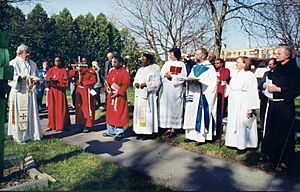
See also
 In Spanish: David Pendleton Oakerhater para niños
In Spanish: David Pendleton Oakerhater para niños
- Native American religion
- Saints in Anglicanism



